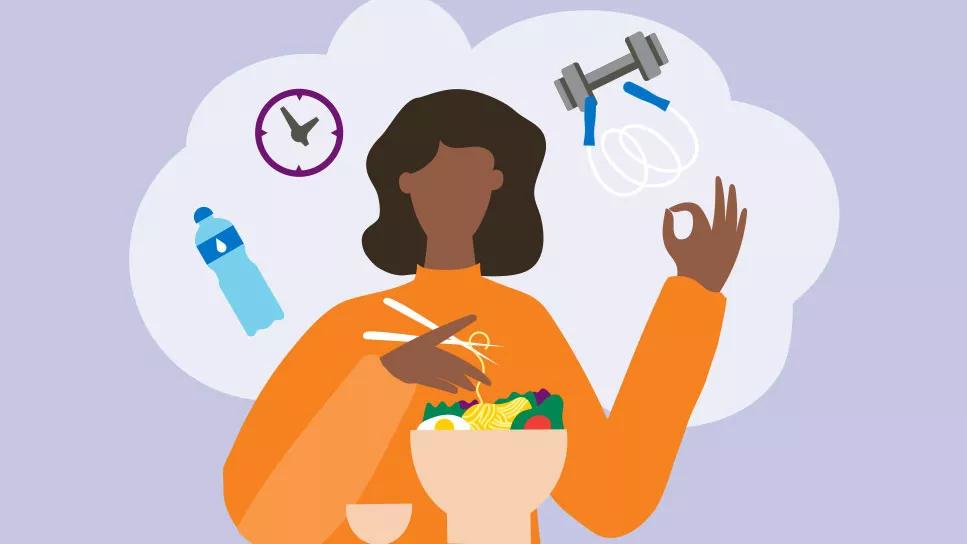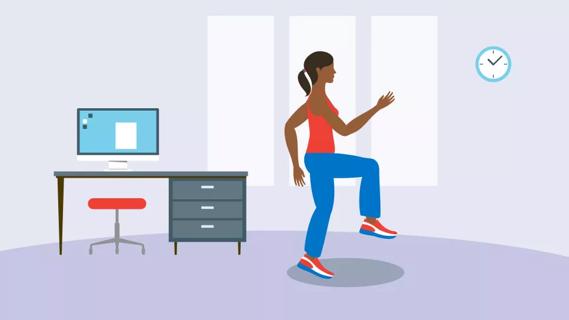Actively choose healthy habits not only when it comes to food and nutrition, but also physical activity and your mental health

Many of us come to stories like this thinking weight management is a numbers game. You count the calories that come in, cross your fingers, and hope they come out just as quickly.
Cleveland Clinic is a non-profit academic medical center. Advertising on our site helps support our mission. We do not endorse non-Cleveland Clinic products or services. Policy
But in truth, weight management and weight loss are more effective and efficient when you’re actively choosing healthy habits in the areas of food, fitness, mental health and physical activity. And when you’re focused on health and wellness, it becomes more about what your body needs to thrive, survive and stay alive than just counting calories.
Whether you’re trying to lose weight for the first time, looking for ways to avoid overeating or just trying to dig a little deeper after coming up against a plateau, our experts provide seven suggestions for dropping your next 10 pounds in a healthier way.
“Listening to your hunger works much better than relying on willpower,” says registered dietitian Kayla Kopp, RD, LD. “When you’re tempted to overeat, have a conversation with yourself: Are you feeling hungry, are you bored or are you feeling emotional? Will eating right now get you closer to your goal?”
Kopp advises picturing a “hunger scale” of 1 to 10 — with 1 being hungry and 10 being so stuffed you can’t imagine eating another bite.
“You never want to be at either of the far ends of the hunger scale,” she says. “Always aim to be somewhere between a 4, 5 or 6.”
And even when you can’t yet break away from less-than-stellar food choices, listening to your hunger can help you lose weight in a passive way.
“Being mindful of what you eat makes you more conscious of your choices, eliminating the ‘oops-did-I-eat-that-whole-bowl?’ behaviors,” says psychologist Susan Albers, PsyD.
Love to pour cereal straight from the box into the bowl? “You wind up with two to three servings — and two to three times the number of calories,” adds Kopp.
Instead, measure out one serving at a time. You’ll find the serving size on the nutrition label.
“It sounds simple, but taking a minute to read the label will make a huge difference in your choices,” says Dr. Albers.
Another tactic is front-loading your calories.
“Try to eat most of your daily calories before sitting down to relax for the night,” advises Kopp. “Many of us have a tendency to overeat without thinking about it while we watch TV after dinner, and we tend to forget just how much we’ve had before calling it a night.”
It’s easy to overlook the calories that come from beverages.
“Think about food as fuel for your body, and then look at the places where you don’t really need extra calories,” recommends Kopp. “Ask yourself if you really need that glass of wine every night, or try to cut back on sodas and other sweet drinks.”
Reducing or eliminating sugary and high-calorie sodas, juices, sweet tea and milkshakes can make a real difference in your weight. Additionally, water is one beverage that will actually help you lose weight while keeping you hydrated. And hydration is key to weight management.
“Sometimes we respond to thirst signals by eating — when actually what our bodies want is water,” explains Dr. Albers. “It’s easy to confuse our thirst and hunger signals, or to override thirst signals.”
If you’re unsure about whether you’re overriding your signals, try drinking some water before eating. Drinking water helps you feel fuller and changes your satiety cues.
“Studies have shown that when people drink water before they eat, they eat less during a meal,” shares Dr. Albers. “Being fully hydrated helps with digestion, nutrient absorption, regulating your appetite hormones and reduces inflammation. All of these are key to being able to hear your hunger and eat in a mindful way.”
Reducing or eliminating processed foods (like cookies, baked goods, junk food) and high-fat foods (like cheese, anything fried) will move you closer to your goal weight.
“Processed and fast foods contain enhanced ingredients that hit the dopamine center in your brain and make you want more,” explains Dr. Albers. “They are designed to be addictive to the brain.”
Shift your focus instead to nutrient-dense foods that are rich in protein and fiber. Both will keep your digestive tract active while providing additional energy and boosting your mood. And Dr. Albers points out that once you return to whole foods, not only will they taste better, but your body also processes them more efficiently and naturally.
“You can increase your protein intake with poultry, lean cuts of red meat/pork, dairy products, and/or beans,” Kopp says. “To increase your fiber content, which is good for your digestive system and will help you feel fuller, add non-starchy vegetables and/or a small salad to lunch or dinner, or both.”
When it comes to exercise guidelines for weight loss, the idea is that you want to try and burn off more calories than you consume on a regular basis. If you’re not exercising and want to lose 30-plus pounds, increasing your activity will help.
“Working up to 30 minutes of moderate-intensity cardiovascular exercise at least five days a week is generally a good starting place because it’s good for your heart,” says exercise physiologist Katie Lawton, MEd. “But it won’t always produce weight loss. Sometimes, you need to exercise more.”
If your current routine focuses on cardio, incorporating a strength routine can help you lose body fat. Weight training builds muscle, which increases your metabolism and burns fat more efficiently. Another benefit of resistance training is that it can burn calories up to 24 to 36 hours after the workout.
Increasing the intensity of cardiovascular exercise, including doing high-intensity interval training (HIIT), can burn calories in a shorter amount of time and also has the benefit of burning calories long after the workout is over.
“HIIT and resistance training are not for everyone, though, especially beginners,” Lawton cautions. “Consult your healthcare provider or an exercise physiologist before trying them, especially if you have any underlying heart conditions.”
Keep in mind, too: You can’t out-exercise a bad diet. So, if you’re looking to maximize all of your effort in the gym, you’ll also want to pair your physical activity with a nutritional plan that healthily fuels your body.
Getting enough sleep is key to weight loss. That’s because fatigue increases your appetite as hunger hormone levels rise.
“No one can make mindful food choices when they’re tired. Even missing an hour of sleep can increase your appetite because your body is craving that energy and food is fuel for your body,” says Dr. Albers. “You need a clear, focused head to make healthier food choices.”
Your stress level is also important. Dr. Albers notes that 75% of eating is triggered by emotions rather than by hunger.
“Many people have lost weight simply by reducing their stress levels and finding ways to soothe themselves without food,” she adds. “If someone’s stress level is high, stress management techniques are key and a necessary first step before they change anything in their diet.”
Not sure how to bring your stress down a notch? Try yoga or other meditative practices.
“When you get on the treadmill every day and your body becomes more efficient, the exercise becomes easier to do and you need to take it up a notch. This efficiency argument applies to your diet as well,” says Kopp.
That’s when a registered dietitian, physician or exercise physiologist can help you figure out next steps, how to scale up the difficulty of your exercises and ways you can continue to push yourself beyond where you are right now.
“We all hit a plateau when we need to do something more aggressive beyond just cutting more calories,” says Kopp. “A professional may have some other ideas and can help you level up along the way.”
On average, it’s safe to lose 1 to 2 pounds a week with the help of a healthy diet and consistent, physical activity. Losing 10 pounds in one week can actually be harmful in the long run. So, if you find yourself losing weight more quickly and/or during shorter periods, you should make an appointment with a healthcare provider who can help figure out how best to meet your weight management goals. And that’s true even if you’re not losing any of your intended weight.
“Transforming your relationship with food and your body can be a challenging process because it’s intertwined with various factors like genetics, personality, learning history and societal messages about food and weight,” recognizes Dr. Albers. “But with the support of a multidisciplinary team, you can navigate these complexities.”
For example, a registered dietitian can assist you in crafting a personalized food plan, while a therapist can delve into the influence your habits, stress and self-image have on your food choices. Consulting with a physician can also provide valuable insight into your overall health and help determine if modifying your eating habits is necessary for your well-being.
“Overall, you want to reduce the pressure and reframe your thoughts to focus on health rather than weight,” advises Dr. Albers.
Make a list of the non-weight-related benefits you want that are linked to healthy habits, such as feeling more comfortable in your clothing, playing with your kids and being more active — and then, work toward those goals.
“Remember, weight doesn’t define health,” encourages Dr. Albers. “You can be healthy and happy at any weight, and the number on the scale doesn’t define your worth or success. It’s more important to focus on nourishing your body, engaging in regular physical activity and adopting mindful eating habits.”
Learn more about our editorial process.

Chair exercises can help people age 65+ retain independence

A well-balanced diet with anti-inflammatory foods can help reduce flare-ups and severity of psoriasis symptoms

Both are needed for a healthy body

Counteract psoas muscle stiffness and soreness with stretches that lengthen and strengthen

It may be OK, depending on your health, fitness level and type of exercise

Simple exercises like wall angels and pelvic tilts can help keep your body in an optimal position — and help undo years of improper posture habits

Wrapped or sandwiched, try to choose fillings and condiments that are minimally processed, low in saturated fat and high in fiber

It depends on factors like your age, activity level and if you want to maintain, lose or gain weight

Your metabolism may torch 1,300 to 2,000 calories daily with no activity

A gentle touch in all the right places may help drain your sinuses